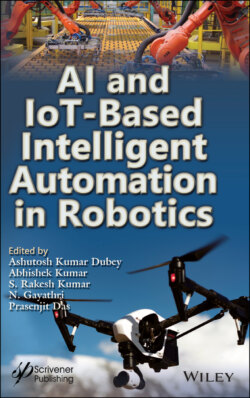Читать книгу AI and IoT-Based Intelligent Automation in Robotics - Группа авторов - Страница 14
1.2 History and Evolution of Robots
ОглавлениеTable 1.1 shows the origins of robotics along with detailed information of when the robots came into existence, the developer’s name, etc. Presently, there are various types of robots which are used for various environments for various users. Moreover, the robots were classified into mechanical construction, electrical components and computer programming mechanism.
Table 1.1 History of the earliest robots.
| Date | Significance | Robot name | Inventor | |
|---|---|---|---|---|
| 3rd century BC and earlier | First humanoid automata based on an earlier description | Yan Shi | ||
| 1st century AD and earlier | Descriptions of more than 100 machines and automata which include a fire engine, a wind organ, a coin-operated machine, and a steam-powered engine | Ctesibius, Philo of Byzantium, Heron of Alexandria, and others | ||
| c. 420 BC | Robot designed like a bird, which will fly | Flying Pigeon | Archytas of Tarentum | |
| 1206 | First humanoid robot with automata mechanism | Robot band, hand-washing automaton [11], automated moving peacocks [12] | Al-Jazari | |
| 1495 | Humanoid robot | Mechanical Knight | Leonardo da Vinci | |
| 1738 | Mechanical duck which can eat, flap its wings, and excrete | Digesting Duck | Jacques de Vaucanson | |
| 1898 | First radio-controlled device | Teleautomaton | Nikola Tesla | |
| 1921 | First fictional automatons called robots | Rossum’s Universal Robots | Karel Čapek | |
| 1930s | Humanoid robot exhibited at the 1939 and 1940 New York World’s Fair | Elektro | Westinghouse Electric Corporation | |
| 1946 | First general-purpose digital computer | Whirlwind | Multiple people | 5 |
| 1948 | Simple robots exhibiting biological behaviors | Elsie and Elmer | William Grey Walter | |
| 1956 | First commercial robot from the Unimation company | Unimate | George Devol | |
| 1961 | First installed industrial robot | Unimate | George Devol | |
| 1967 to 1972 | First full-scale humanoid intelligent robot | WABOT-1 | Waseda University | |
| 1973 | First industrial robot with six electromechanically driven axes | Famulus | KUKA Robot Group | |
| 1974 | First microcomputer controlled electric industrial robot, IRB 6 from ASEA, which was already patented in 1972. | IRB 6 | ABB Robotics | |
| 1975 | Programmable universal manipulation arm, a Unimation product | PUMA | Victor Scheinman | |
| 1978 | First object-level robot programming language, which allows robots to handle variations in object position, shape, and sensor noise | Freddy I and II, RAPT robot programming language | Patricia Ambler and Robin Popplestone | |
| 1983 | First multitasking, parallel programming language used for a robot control | ADRIEL I | Stevo Bozinovski and Mihail Sestakov |
The mechanical part of the robot is designed for mechanical purposes such as designing the particular shape and processing of the particular task. With the mechanical components it also follows the physics friction mechanism for processing of the task.
The robots have the electrical power capable of handling the mechanical products because the electricity is capable of handling the machine [3]. Even though there are petrol-based robots, they still require electrical energy in order to function, just as a car works with a battery.
